#Florida insect larvae
Text
Our Beautiful Ladybug Larva are Growing Up
Our Beautiful Ladybug Larva are Growing Up features images of a fourth instar larval ladybug. This larva is very close to pupating. It compares this larva to a much younger one presented earlier and discusses how these changes occur in a very short time.
On Edge
Back in June, I shared a post showing an interesting insect that I found on one of my hikes. It turned out to be a larval seven spotted ladybug (Coccinella septempunctata), which was a surprise to me and to many of you. It looked more like a caterpillar than it did a ladybug, but it was definitely still very pretty. At the end of July, I found another insect that I took to be some sort…

View On WordPress
#colorful insects#Florida insect larvae#Florida insects#Florida ladybug larvae#Florida ladybugs#insect larvae#insect photographs#insect photography#insects#ladybug larvae#ladybug photographs#ladybug photography#ladybugs#larvae#photography#seven spotted ladybug#seven spotted ladybug larvae#summer insects
0 notes
Text
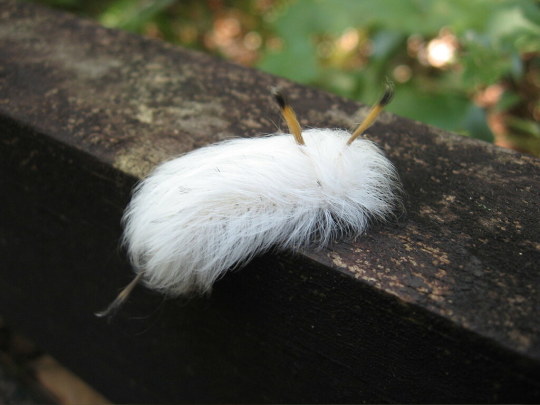
"Shaggy Dog Caterpillar," Spotted Apatelodes moth larva, (Apatelodes torrefacta). By J.S. Clark on Flickr. (Larger)
#puppy#larva#larvae#moth#moths#moth larva#moth larvae#apatelodes#apatelodes torrefacta#spotted apatelodes#spotted apatelodes moth#spotted apatelodes moths#shaggy dog catepillar#shaggy dog caterpillars#insect#insects#animal#animals#florida#america#u.s.a.#nature
20 notes
·
View notes
Text
Wool-Carder Bees: these solitary bees harvest the soft, downy hairs that grow on certain plants, rolling them into bundles and then using the material to line their nests

Wool-carder bees build their nests in existing cavities, usually finding a hole/crevice in a tree, a plant stem, a piece of rotting wood, or a man-made structure, and then lining the cavity with woolly plant fibers, which are used to form a series of brood cells.
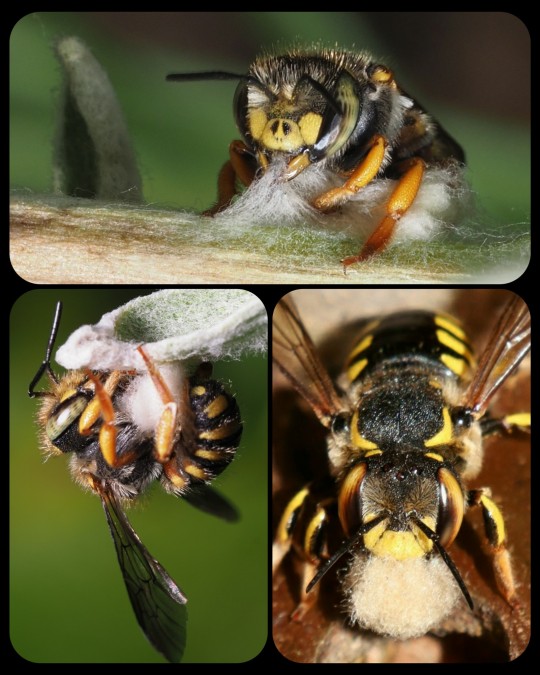
The fibers (known as trichomes) are collected from the leaves and stems of various plants, including lamb’s ear (Stachys byzantina), mulleins, globe thistle, rose campion, and other fuzzy plants.

From the University of Florida's Department of Entomology & Nematology:
The female uses her toothed mandibles to scrape trichomes off fuzzy plants and collects a ball of the material under her abdomen. She transports these soft plant fibers to her selected nest site and uses them to line a brood cell. Next, she collects and deposits a provision of pollen and nectar into the cell, enough pollen to feed a larva until it is ready to pupate. Lastly, she lays a single egg on top of the pollen and nectar supply before sealing the cell. ... She will repeat this process with adjoining cells until the cavity is full.
These are solitary bees, meaning that they do not form colonies or live together in hives. Each female builds her own nest, and the males do not have nests at all.
Female wool-carder bees will sometimes sting if their nest is threatened, but they are generally docile. The males are notoriously aggressive, however; they will often chase, head-butt, and/or wrestle any other insect that invades their territory, and they may defend their territory from intruders up to 70 times per hour. The males do not have stingers, but there are five tiny spikes located on the last segment of their abdomen, and they often use those spikes when fighting. They also have strong, sharp mandibles that can crush other bees.
There are many different types of wool-carder bee, but the most prolific is the European wool-carder (Anthidium manicatum), which is native to Europe, Asia, and North Africa, but has also become established as an invasive species throughout much of North America, most of South America, and New Zealand. It is the most widely distributed unmanaged bee in the world.
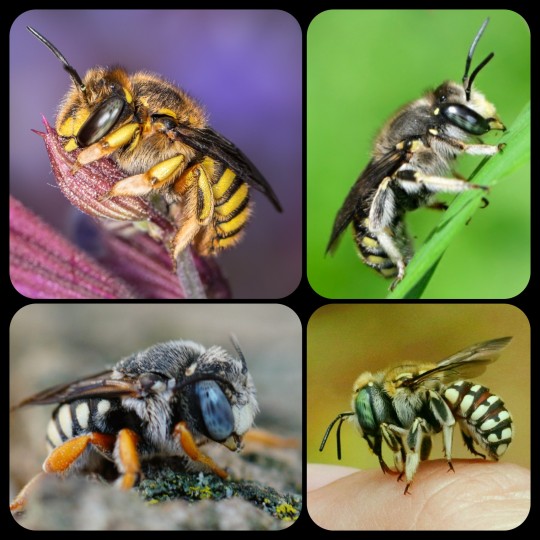
A few different species of wool-carder bee: the top row depicts the European wool-carder, A. manicatum (left) and the spotted wool-carder, Anthidium maculosum (right), while the bottom row depicts the reticulated small-woolcarder, Pseudoanthidium reticulatum, and Porter's wool-carder, Anthidium porterae
Sources & More Info:
University of Florida: The Woolcarder Bee
Oregon State University: European Woolcarder Bees
Bohart Museum of Entomology: Facts about the Wool Carder Bee (PDF)
Bumblebee Conservation Trust: A. manicatum
World's Best Gardening Blog: European Wool Carder Bees - Likeable Bullies
Biological Invasions: Global Invasion by Anthidium manicatum
#entomology#hymenoptera#apiology#melittology#bees#woolcarder bees#nature#insects#arthropods#science#solitary bees#european woolcarder#anthidium#animal facts#cool bugs#cute animals
3K notes
·
View notes
Photo

Field journal 📔 ID: Chrysomela scripta Fabricius Common name: Cottonwood leaf beetle larva 🪲 This little guy is going to grow up and become an economically-important pest of managed trees. (Which is a really weird way of saying that they can harm urban ornamental trees and tree plantations.) They are not a pest in forests because they coexist with that habitat. They can spend their entire life cycle feeding on their host plant, cottonwood trees, though they are sometimes observed eating other species such as aspen, poplar, and willow. 🪲 This particular buggy that I spotted was having a great time on this plant. I loved the pink leaves but didn’t pay close enough attention to the rest of the tree or take better photos of it, so I don’t know for sure what it is. The green leaves look like they could be this beetle’s host tree of cottonwood, but that tree’s range is supposed to end a little north of here. Also, I couldn’t find any sources that documented the new leaf growth as being this pretty pink color. Anybody have any ideas? 🪲 Observed in Manatee County, Florida ☀️ 🌱 🔍 #florida #bug #beetle #macro #nature #naturelovers #larva #entomology #tgif_insects #insect #nature_brilliance #fiftyshades_of_nature #manateecounty #ChrysomelascriptaFabricius #cottonwoodleafbeetle #green https://www.instagram.com/p/CcjdHKTrxtS/?igshid=NGJjMDIxMWI=
#florida#bug#beetle#macro#nature#naturelovers#larva#entomology#tgif_insects#insect#nature_brilliance#fiftyshades_of_nature#manateecounty#chrysomelascriptafabricius#cottonwoodleafbeetle#green
0 notes
Text
Eyed Elaters (Alaus)
eyed elater click beetles, like this Alaus oculatus from Florida, are the biggest click beetles (Elateridae) found in temperate North America.
Click beetles are best known for their eponymous clicking ability- a sort of elastic locking mechanism on their thorax can snap open with a loud clicking sound, which helps them startle or escape the grasp of predators and allows them to launch themselves into the air when overturned (you can see that in slow motion at the end of the video)
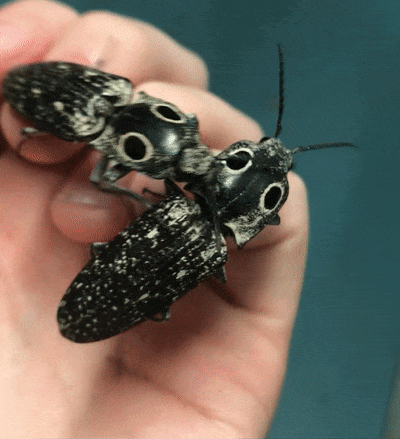

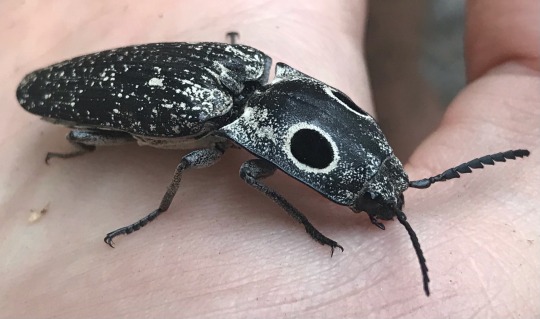
(more elating click beetle trivia below!)
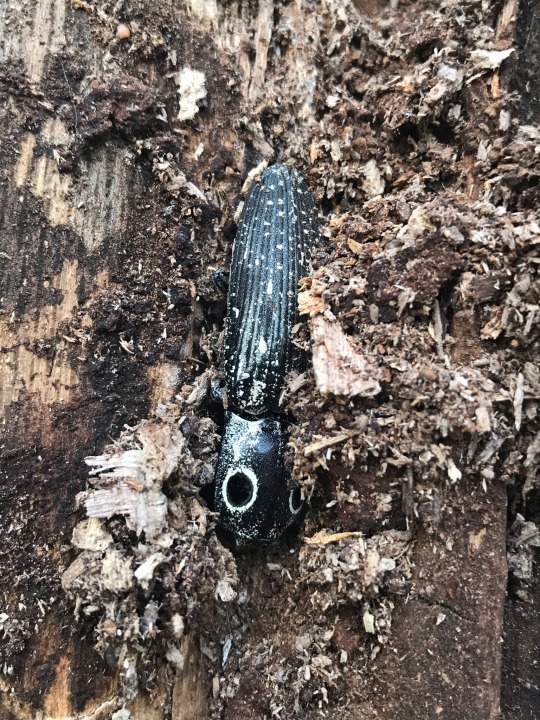

They live around decaying trees and logs, the adults feeding on sap flows and other sugary liquids while the predatory grubs use their powerful jaws to tunnel in search of other wood-dwelling insect larvae to devour (by contrast many smaller click beetle larvae, often called wireworms, feed on rotting wood itself or other plant matter). To rear these beetles in captivity it’s necessary to keep the larvae in containers made of a hard material like glass, as they’ll chew through plastic and escape (I learned this the hard way the first time I found and attempted to raise a grub).
There are 6 Alaus species in the US, the largest of which can be over 5 cm long. Two are found in forests along the east coast- A. oculatus, the eastern eyed elater (below, left) and its smaller relative A. myops, the blind elater (right).


Even though the larvae don't feed directly on decaying wood, different Alaus species prefer different trees- oculatus breeds in dead oaks and other hardwoods, while myops found in the same habitats only use well-rotted pines.
#beetles#elateridae#click beetle#coleoptera#Alaus#eyed elater#Alaus oculatus#Alaus myops#bugs#bugblr#entomology#insects
2K notes
·
View notes
Note
I am a teacher and want to do a unit on bugs for my kindergarteners and preschoolers and I would love to have some live bugs as a class pet.
I would keep the critters after the unit ( I’ve always wanted some and it’s a great excuse to get work to buy it)
Do you have a recommendation on beginner critters that we would be able to observe easily?
I think isopods are a great option since they are harmless, can be colorful, and do well on minimal care! I’ve always thought isopods would be great class pets since they also are good at demonstrating laws of genetics, convergent evolution etc. for older students.
you’d probably do well with Porcellio scaber or Armadillidium vulgare, both hardy temperate species available in a rainbow of color morphs (and often sold in mixed-color cultures). since they eat dead tree leaves, it might be a fun idea to have your kids go outside and gather dead leaves to feed their class pets (make sure it’s away from pesticides). one issue might be that both species are strictly nocturnal and aren’t reliably visible in captivity, spending their time in hiding. you can still flip their hides to find them, but it's best to keep that to a minimum.
if isopods are too mundane, I also suggest cockroaches like dubia or Madagascar hissers. while hissers can climb, dubia can't, and both are harmless and popular insect ambassadors at museums. hissers are good for handling but they still need to be treated gently, and have sharp spines on their legs that they can use to enforce that. if you’re in the southeast esp. Florida these are not legal to keep but I can suggest alternatives.
mealworms and superworms are beetle larvae that eat just about anything and are very hardy to dryness. their complete metamorphosis makes them good teaching species; the superworm Z. atratus avoids pupating in a colony setting so it’s perfect for isolating in little vials so you can watch its transformation into pupa and beetle.
plain old pet store crickets are a very active option too but Acheta domesticus die quickly due to viruses and generally being a crappy bug. if you want crickets find Gryllodes sigillatus—they’re quieter and longer-lived but much more agile
143 notes
·
View notes
Text
February 21st, 2024

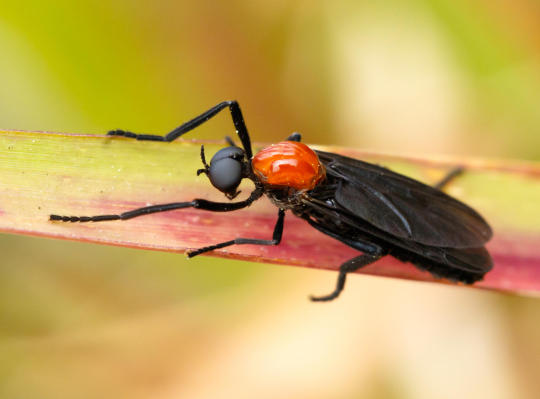
Lovebug (Plecia nearctica)
Distribution: Native to Central America and the Southeastern USA (Alabama, Florida, Georgia, Louisiana, Mississippi, South Carolina and Texas). Most common in Texas and Louisiana.
Habitat: Can be found in almost all habitats, but most common in grassy areas; most common around fresh-cut lawns, animal pastures and areas with decaying vegetation. Found at altitudes of over 450 metres.
Diet: Larvae feed on decaying vegetation; adults feed on the nectar of plants such as sweet clover, goldenrod and Brazilian pepper.
Description: This insect is called the lovebug because mated pairs often stay together for days at a time during and after mating, with flights of mating lovebugs sometimes numbering into the millions. These flights can be quite a nuisance to drivers, as they easily splatter onto windshields and hoods at highway speeds. The acidic body chemistry of dead bugs, left for even just a handful of hours, makes them incredibly difficult to scrape off car parts; what's more, they also have a tendency to cause pits in automotive paint when left untouched for too long, or can cause radiators to overheat. Because they're attracted to fresh paint, lovebug corpses are also a common sight in the dried paint on buildings.
There is many myths surrounding lovebugs, perhaps due to how common they are. One myth claims that these insects were genetically engineered by the University of Florida in order to control mosquito populations (disregarding the fact that they're herbivorous, and thus would make poor pest control!). Another myth claims that lovebugs escaped from the University of Florida after being transported there by scientists; while their original range includes only Louisiana and Mississippi, populations naturally spread north- and southward. For some reason, this insect has many University of Florida-related conspiracies!
Images by Judy Gallagher and Chris Rorabaugh.
85 notes
·
View notes
Text




The Perfect Pileated Woodpecker
The Pileated woodpecker (Dryocopus pileatus) is a common sight throughout the deciduous and mixed forests of North America, from Nova Scotia in Canada to Florida in the United States. Though they can adapt to many forested environments, their preferred habitats are old-growth hardwood forests, with plenty of open space in the canopy and on the ground.
The distinctive look of D. pileatus makes it a near-perfect stereotype for the woodpecker group. Both males and females have a large red crest, white markings streaking from the face to the shoulder, and a black body. The main distinction between the sexes is that the males also have a red line going from the bill to the throat. This species is also the largest woodpecker in North America, sitting at a body mass of 225 to 400 g (7.9 to 14.1 oz) and a wingspan of 66 to 75 cm (26 to 30 in).
As is characteristic of woodpeckers the pileated woodpecker feeds primarily on insects, particularly carpenter ants and wood-boring beetle larvae, but they also consume wild fruits and nuts when available. To find food, individuals use their strong beaks to peck holes in dead wood and suck out insects with their long tongues. Their feet are zygodactyl, meaning there are two toes in front and two in the back, and are handy for clinging to the trunks of trees. Adults can fall prey to hawks and owls, while nestlings are susceptible to martins, weasels, squirrels, and rat snakes.
Pileated woodpeckers make their nests in dead or dying trees, and single roost will often have several entrances. Though males and females share territories, they often nest seperately, only coming together during the mating season. Courtship begins in early February and lasts throughout the spring. Males entice females by drumming loudly on tree trunks, dancing around them, and calling. Afterwards, the pair excavates a nest together and the female lays a brood of 3-5 eggs. The clutch is tended by both parents for about 15-18 days, at which point the eggs hatch.
Hatchlings are fed by both parents for about four weeks, at which time they're ready to leave the nest. However, they won't leave the nest for several more weeks as they learn how to find food and fend for themselves. By the time they're a year old, they are fully mature, and can live to be up to 10 years old. The parents abandon the nest, though they will remain mated for life and build a new roost the following year. Once abandoned, these holes will often be used by other passerine birds, ducks, or owls.
Conservation status: D. pileatus is considered Least Concern by the IUCN. They are well adapted to living near humans, and can be found in smaller stands of trees. However, the deforestation of old-growth forests is a significant threat to their livlihoods.
If you like what I do, consider leaving a tip or buying me a ko-fi!
Photos
Mick Thompson
Nick Viani
Daniel Brown
Frank Lospalluto
#Pileated woodpecker#Piciformes#Picidae#woodpeckers#birds#deciduous forests#deciduous forest birds#mixed forests#mixed forest birds#north america#eastern north america#northern north america
66 notes
·
View notes
Text
Types of Bears:
Black Bears:
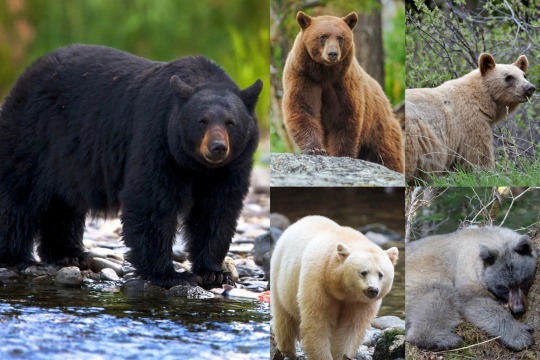
The American Black Bear (Ursus americanus) is a medium-sized bear species native to (you guessed it!) North America. Black Bears can be found in the forests as south as Florida and as North as Alaska. Being so widely distributed it’s no surprise that their population is twice the size of all the other bear species combined! Males generally weigh up to 500lbs, while females weigh up to 300lbs. The heaviest bear on record was found in North Carolina in 1998, weighing in at 880 lbs. Despite what their name may lead you to believe, they actually come in many different colors! They can be cinnamon, blonde, kermode or glacier bears as well as black! These bears are omnivores but their diet varies greatly depending on season, location, etc. They may eat berries, carrion nuts, insect larvae, fish, grasses, and small mammals. Although an adult Black Bear is quite capable of killing a person, they typically avoid any interaction or confrontations with humans. Attempts to relocate American black bears are typically unsuccessful, as the bears are able to return to their home range, even without familiar landscape cues.
Brown Bears:

The Brown Bear (Ursus arctos) is a species of large bear found across North America and Eurasia. In North America, the populations of brown bears are called grizzly bears, while the even larger subspecies that inhabits the Kodiak Islands of Alaska is known as the Kodiak bear. The largest populations are are in Russia with 120,000, the United States with 32,500, and Canada with around 25,000. Males generally weigh up to 600lbs , while females weigh up to 350lbs with the largest Brown Bear on record was a Kodiak that weighed 1,656 lbs. The Brown Bear is omnivorous and has been recorded consuming the greatest variety of foods of any bear. They may eat fish, carrion, insects, fungi, berries, flowers, nuts and small-medium sized mammals. Brown Bears do go out of their way to avoid humans but are much more likely to attack than Black Bears. They are formidable indeed, with females being extremely quick to aggression when with cubs.
Sloth Bear:

The Sloth Bear (Melursus ursinus), also known as the Indian bear, is a medium-sized bear species native to the Indian subcontinent. Their population inhabits the forests and grasslands of India, the Terai of Nepal, Bhutan and Sri Lanka. Males generally weigh up to 380lbs, while females weigh up to 210lbs with the biggest Sloth Bear on record weighing 423 lbs. Sloth Bears are considered myrmecophagous, meaning they feed on ants and termites. It has also been called the “labiated bear" because of its long lower lip and palate used for sucking up insects. They also may eat fruits and flowers. The Sloth Bear is one of the most aggressive bears alive which is likely due to the large human populations living so close to their habitats. These attacks are pretty frequent and if not fatal, the victim is often left terribly disfigured, as the bear strikes at the head and face.
Andean Bear:

The Andean Bear (Tremarctos ornatus) also known as the Spectacled Bear is a species of medium-sized bear native to the Andes Mountains in western South America. It is the only living species of bear native to South America, and the last remaining short-faced bear. Males generally weigh up to 340lbs, while females weigh up to 190 lbs with the largest Andean Bear on record weighing 440 lbs. Andean Bears are omnivores, eating small mammals, birds, and berries with their favorite foods being fruits and bromeliads. There have never been any reported attacks on humans.
Sun Bear:

The Sun Bear (Helarctos malayanus) is a species of small bear native to the tropical forests of Southeast Asia. They can grow up to be 150 lbs with males being 1/3 larger than the females. Sun bears get their name from the characteristic cream coloured chest patch! They are the most arboreal natured of all the bears with long claws fit for climbing trees. They feed omnivorously on insects, berries, fruits and mammals. They do not seem to hibernate, possibly because food resources are available the whole year throughout the range. Sun bears are shy and reclusive animals, and usually do not attack humans unless provoked to do so.
Polar Bear:

The Polar Bear (Ursus maritimus) is a species of large bear native to the Arctic Circle. Males generally weigh up to 1,200lbs, while females weighing up to 700lbs with the largest Polar Bear record weighing 2,209 lbs. Although most polar bears are born on land, they spend most of their time on the sea ice. Their scientific name means "maritime bear" and derives from this fact. Polar Bears are hypercarnivorous feeding primarily on ringed seals, but will also eat bearded seals, harp seals, hooded and harbor seals. Larger prey species such as walrus, narwhal and beluga are occasionally hunted. Due to location, attacks on humans are infrequent but potential chances of survival are very low. “If it’s black: fight back, if it’s brown: lay down, if it’s white: goodnight.”
(I'm experiencing a minor bear hyperfixation, if you can't tell!!! I hope this was beary educational for you ROFLROFLROFL)
#bear#bears#educational#grizzly bear#polar bear#black bear#spirit bear#sun bear#sloth bear#spectacled bear
107 notes
·
View notes
Text
Fireflies, known as lightning bugs in the South and Midwest, are neither flies nor bugs. Scientists save the word “bug” for a specific kind of insect with sucking mouthparts—a definition that excludes ants, butterflies and beetles. Fireflies are beetles—magical, but still six-legged insects.
Adult fireflies use their glow as “a love song in light,” as Tennessee-based firefly expert Lynn Faust puts it. A male will flash his signal, and a female will flash a response when she recognizes one of her own species. The females of a few firefly species Heckscher studies can also manipulate their flashes to lure fireflies from other species, which they then eat. In firefly larvae, the glow warns predators of toxic chemical defenses, much as the red of a ladybug or the orange of a monarch butterfly does.
A number of land creatures make light from chemicals, including various fungi, earthworms, millipedes and fungus gnats, Lewis writes. But beetles are the champion, with about 2,500 different species that make light, most of them fireflies. Their glow comes from an abdominal organ called the lantern. Inside that organ, oxygen interacts with a small, energy-packed molecule called luciferin. Some scientists believe fireflies create their pulsating patterns by regulating the flow of air.
There are at least 2,200 firefly species around the globe. Each has a glowing larval (immature) form. These larvae eat snails, slugs and worms, punching way above their weight in the web of life. But not all firefly species have adults that glow. Roughly 60 to 75 percent do, according to Oliver Keller, a biologist with the Florida Department of Agriculture and Consumer Services, who is putting together a checklist of the world’s firefly species. These species are mostly found in Asia and in North America, east of the Rocky Mountains. Fireflies thrive where the air and the ground are moist, and the American West is generally too dry for their taste.
The remaining firefly species are “dark” fireflies. They glow in their juvenile forms, and often as eggs, but not as adults. Instead, these adults find each other through scent-like pheromones, which they detect with elaborate antennae. These fireflies lack the lantern organ that fireflies use to flash. (There are also intermediate species that have both a tiny light organ and elaborate antennae to detect pheromones.) In some other species, the female firefly emits a weak, steady glow but does not fly. She merely crawls to the top of a blade of grass or, perhaps, up a tree trunk.
— The Illuminating Science Behind Fireflies
#madeline bodin#the illuminating science behind fireflies#environmentalism#ecology#entomology#insects#fireflies#bioluminescence#luciferin#lynn faust#sara lewis#oliver keller
53 notes
·
View notes
Text
This extremely interesting article is locked behind a paywall, so I've... cracked open the page source for the lovely people of tumblr and re-transcribed the article. Have fun.
------------------------------------------------------------------------
Deep in the forests of Germany, nestled neatly into the hollowed-out shells of acorns, live a smattering of ants who have stumbled upon a fountain of youth. They are born workers, but do not do much work. Their days are spent lollygagging about the nest, where their siblings shower them with gifts of food. They seem to elude the ravages of old age, retaining a durably adolescent physique, their outer shells soft and their hue distinctively tawny. Their scent, too, seems to shift, wafting out an alluring perfume that endears them to others. While their sisters, who have nearly identical genomes, perish within months of being born, these death-defying insects live on for years and years and years.
They are Temnothorax ants, and their elixirs of life are the tapeworms that teem within their bellies—parasites that paradoxically prolong the life of their host at a strange and terrible cost.
A few such life-lengthening partnerships have been documented between microbes and insects such as wasps, beetles, and mosquitoes. But what these ants experience is more extreme than anything that’s come before, says Susanne Foitzik, an entomologist at Johannes Gutenberg University Mainz, in Germany, who studies the ants and their tapeworms. Infected Temnothorax ants live at least three times longer than their siblings, and perhaps much more, she and her colleagues report in a study published today in Royal Society Open Science. No one is yet sure when the insects’ longevity tops out, but the answer is probably in excess of a decade, approaching or even matching that of ant queens, who can survive up to 20 years.
“Some other parasites do extend life spans,” Shelley Adamo, a parasite expert at Dalhousie University, in Nova Scotia, who was not involved in the study, told me. “But not like this. Under typical circumstances, Temnothorax ants live as most other ants do. They reside in communities ruled by a single fertile queen attended by a legion of workers whose professional lives take a predictable trajectory. They first tend the queen’s eggs as nurses, then graduate into foraging roles that take them outside the nest. Apart from the whole freaky parasite thing, “they are pretty boring,” Foitzik told me.
Normalcy goes out the door, however, when Temnothorax larvae ingest tapeworm-egg-infested bird feces trucked in by foragers. The parasites hatch and set up permanent residence in the young ants’ abdomens, where they can access a steady stream of nutrients. In return, they offer their host an unconventional renter’s fee: an extra-long life span that Foitzik and her colleagues managed to record in real time.
The researchers spent three years monitoring dozens of Temnothorax colonies in the lab, comparing the fates of workers who’d fallen prey to the parasites and those who remained infection-free. By the end of their experiment, almost every single one of the hundreds of worm-free workers had, unsurprisingly, died. But more than half the parasitized workers were still kicking—about the same proportion as the colonies’ ultra-long-lived queens. “That was amazing to see,” Biplabendu Das, an ant biologist and parasite expert at the University of Central Florida, who wasn’t involved in the study, told me. And despite their old age, the ants’ bodies still bore the hallmarks of youth. They were difficult to distinguish from uninfected nurses, who are usually the most juvenile members of the colony’s working class.
The tapeworm-laden ants didn’t just outlive their siblings, the team found. They were coddled while they did it. They spent their days lounging in their nest, performing none of the tasks expected of workers. They were groomed, fed, and carried by their siblings, often receiving more attention than even the queen—unheard of in a typical ant society—and gave absolutely nothing in return.
The deal the ants have cut with their parasites seems, at first pass, pretty cushy. Foitzik told me that her team couldn’t find any overt downsides to life as an infected ant, a finding that appears to shatter the standard paradigm of parasitism. Even the colonies as a whole remained largely intact. Workers continued to work; queens continued to lay eggs. The threads that held each Temnothorax society together seemed unmussed.
Only when the researchers took a closer look did that tapestry begin to unravel. The uninfected workers in parasitized colonies, they realized, were laboring harder. Strained by the additional burden of their wormed-up nestmates, they seemed to be shunting care away from their queen. They were dying sooner than they might have if the colonies had remained parasite-free. At the community level, the ants were exhibiting signs of stress, and the parasite’s true tax was, at last, starting to show. “The cost is in the division of labor,” Das said. The worms were tapping into not just “individual [ant] physiology, but also social interactions,” Farrah Bashey-Visser, a parasitologist at Indiana University who wasn’t involved in the study, told me.
"Scientists think of social insects not as single bugs, but as interlaced parts of a giant “superorganism,” Manuela Ramalho, an ant biologist at Cornell University, who wasn’t involved in the study, told me. When one individual acts, others around it react; in a colony, no ant can truly act alone. Parasites of these communities automatically extend their reach to multiple animals at once, a rippling mind-control effect that spreads and amplifies the consequences of infection. Although the tapeworms had infected only a fraction of the Temnothorax workers, they were puppeteering the entire society.
That altered existence might play directly into the parasite’s hands. Tapeworms of these species can’t mature into adults and produce eggs until their ant host is consumed by a bird—a fate that insects in full possession of their faculties try to avoid. But ants who spend all their time lazing around the house make for easy prey; hosts who are pampered and long-lived have a high chance of surviving until they’re eaten. The worm’s most ingenious move might play out in some ants’ final moments, as they trade their natural fear of intruders for a dollop of ennui. When Foitzik and her students crack open infected Temnothorax colonies, the parasitized workers do little more than stare expectantly skyward. “Everyone else is just taking the larvae and running,” Foitzik said. “The infected workers are just like, Oh, what’s going on?”
Down to the molecular level, the parasite is pulling the strings. Sara Beros, Foitzik’s former doctoral student and the paper’s first author, told me she has split open Temnothorax abdomens and counted up to 70 tapeworms inside. From there, the worms can unleash a slurry of proteins and chemicals that futz with the ant’s core physiology, likely impacting their host’s hormones, immune system, and genes. What they achieve appears to be a rough pantomime of how ant queens attain their mind-boggling life span, a feat humans still don’t understand. (The tapeworms’ grasp of ant aging is far more advanced than ours.) The parasites are effectively flash-freezing their host into a preserved state—one that will up their own chances of survival, and help guarantee that their species lives on.
The worms’ MO is subtle and ingenious. They are agents not of disaster, but of an insidious social sickness that sets reality only slightly, barely perceptibly, askew. Infected workers get a taste of invincibility and status, swaddling themselves in youth and the benefits it brings. They also form resource sinks that sap the energy of those around them. They become echoes of the microorganisms they harbor. They are, in the end, parasites themselves.
------------------------------------------------------------------------
16 notes
·
View notes
Text
The Luna Moth Caterpillar is Beautiful and Stunning
The Luna Moth Caterpillar is Beautiful and Stunning shows readers a fourth instar Luna moth caterpillar. It discusses how beautiful both the caterpillars and the moths are tells a little bit about their unusual lifestyle.
Luna Moth Caterpillar
One of our biggest and arguably prettiest large moths in eastern North America is the Luna moth (Actias luna), also known as the American moon moth. The moth itself has a three to four inch wing span with very pretty green wings and long flowing tails off of the hind wings. I have seen Luna moths several times, although always at night in poor light, so I’ve never gotten…

View On WordPress
#American moon moth caterpillars#American moon moth larvae#American moon moths#caterpillar photographs#caterpillar photography#colorful Florida moths#colorful insects#Florida insects#Florida moths#green caterpillars#green moths#insect photographs#insect photography#insects#large caterpillars#large moths#luna moth caterpillar#luna moth caterpillar photographs#luna moth larvae#luna moths#moth caterpillars#moth larvae#moths#photography
0 notes
Text
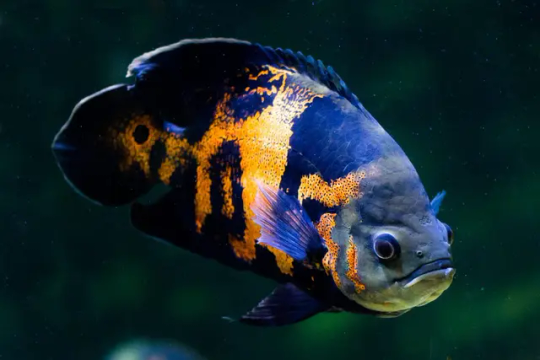

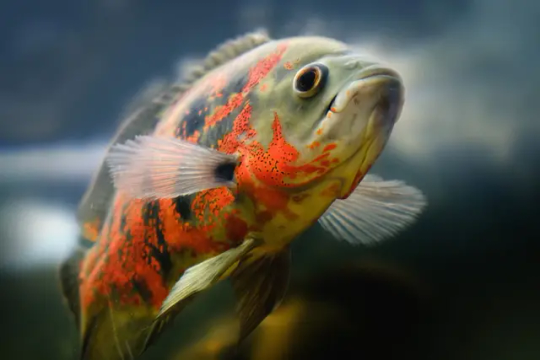
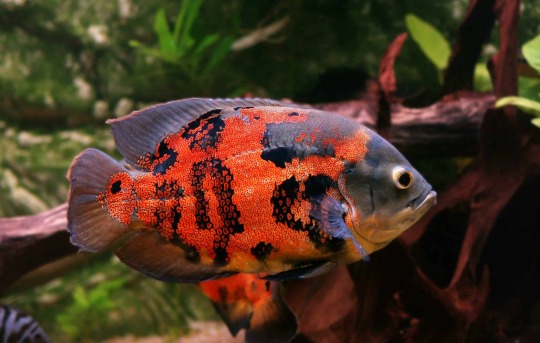

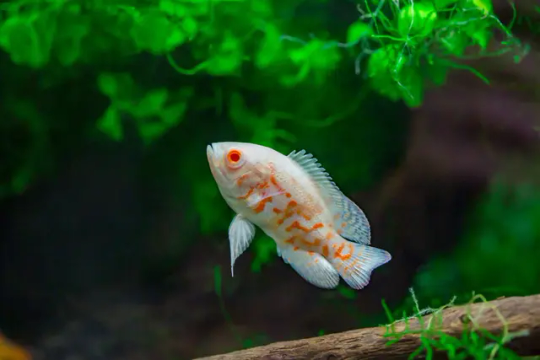

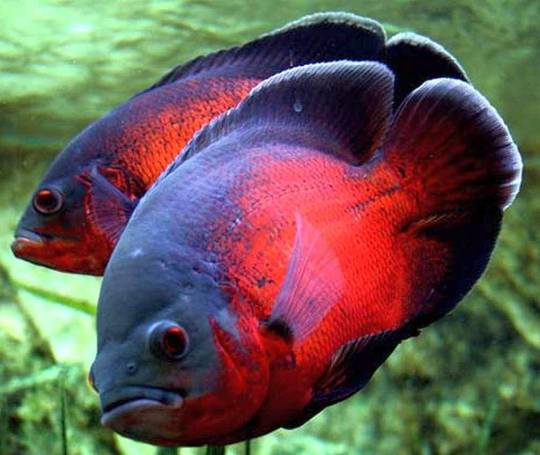
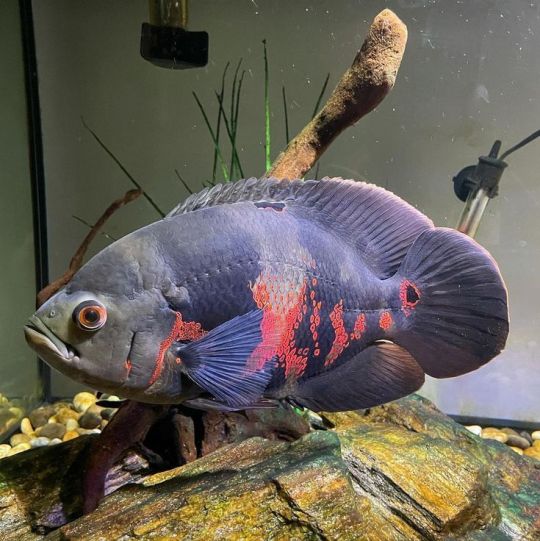
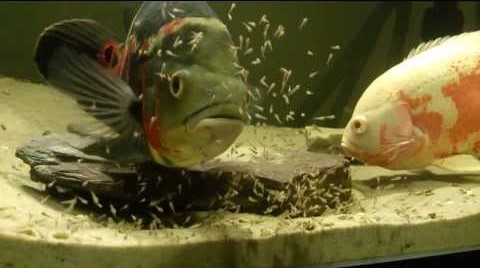
Astronotus ocellatus better known as the tiger oscar, velvet cichlid, marble cichlid, or simply the Oscar is a species of fish from the cichlid family: Cichlidae, which is native to the warm tropical slow moving rivers, creeks, and lakes of Brazil, Colombia, Ecuador, Guyana, French Guiana, Suriname, Peru, and Venezuela. They have also been introduced to China, Australia, and the US state of Florida. They are a territorial species which typically creates a home base in a radius around a series of rocks or submerged branches which it will vigorously defend it by chasing away other fish. Oscars are omnivorous animals which use a suction mechanism to capture prey, feeding upon worms, crustaceans, snails, insects and insect larvae, smaller fish, as well as fruits and nuts. Oscars are themselves eaten by larger fish, turtles, crocodilians, snakes, certain birds, and various mammals such as otters, cats, and freshwater dolphins. Reaching around 18 inches (45cms) in length and 3.5lbs (1.6kgs) in weight, the Oscar is a stoutly built fish which is are typically darkly colored with yellow-ringed spots or ocelli on the caudal peduncle and on the dorsal fin. Albino, leucistic, mellanistic, and xanthic individuals are also very common. Most juvenile oscars have a different coloration from adults, and are striped with white and orange wavy bands and have spotted heads. Oscars are also able to rapidly alter the shades of its coloration, which it uses in territorial and mating displays. Breeding occurs during heavy rains, during such time the female lays her eggs on a flat rock or a cleared-out of substrate. Once the male fertilizes the eggs, they both aggressively guard their brood against would-be predators until the young hatch into fry and spread out on there own. Under ideal conditions an Oscar will reach sexual maturity at around 1 to 1.5 years of age and may live up to 20.
#pleistocene pride#pleistocene#pliestocene pride#pliestocene#cenozoic#ice age#stone age#fish#oscar#oscars#oscar fish#south america#freshwater#aquariums#fish tank#fishkeeping
2 notes
·
View notes
Text
Twenty-five years ago, Heckscher was a wildlife biologist with the State of Delaware’s Natural Heritage and Endangered Species Program, managing the state’s rarest species. One project had him searching for the Bethany Beach firefly, which hadn’t been seen since 1968. Was the firefly extinct, falling to one or all of the hazards threatening fireflies throughout the world, such as habitat loss, light pollution and climate change? Or had it simply gone unnoticed for 30 years? The scientific species description gave few hints, only that it had been found in Bethany Beach, Delaware. Frank Alexander McDermott, a researcher who wrote dozens of articles on fireflies, published the first paper about it in 1953. James E. Lloyd, a professor at the University of Florida known as the “Firefly Doc,” had been the last to see it.
Fireflies, known as lightning bugs in the South and Midwest, are neither flies nor bugs. Scientists save the word “bug” for a specific kind of insect with sucking mouthparts—a definition that excludes ants, butterflies and beetles. Fireflies are beetles—magical, but still six-legged insects.
Adult fireflies use their glow as “a love song in light,” as Tennessee-based firefly expert Lynn Faust puts it. A male will flash his signal, and a female will flash a response when she recognizes one of her own species. The females of a few firefly species Heckscher studies can also manipulate their flashes to lure fireflies from other species, which they then eat. In firefly larvae, the glow warns predators of toxic chemical defenses, much as the red of a ladybug or the orange of a monarch butterfly does.
A number of land creatures make light from chemicals, including various fungi, earthworms, millipedes and fungus gnats, Lewis writes. But beetles are the champion, with about 2,500 different species that make light, most of them fireflies. Their glow comes from an abdominal organ called the lantern. Inside that organ, oxygen interacts with a small, energy-packed molecule called luciferin. Some scientists believe fireflies create their pulsating patterns by regulating the flow of air.
There are at least 2,200 firefly species around the globe. Each has a glowing larval (immature) form. These larvae eat snails, slugs and worms, punching way above their weight in the web of life. But not all firefly species have adults that glow. Roughly 60 to 75 percent do, according to Oliver Keller, a biologist with the Florida Department of Agriculture and Consumer Services, who is putting together a checklist of the world’s firefly species. These species are mostly found in Asia and in North America, east of the Rocky Mountains. Fireflies thrive where the air and the ground are moist, and the American West is generally too dry for their taste.
The remaining firefly species are “dark” fireflies. They glow in their juvenile forms, and often as eggs, but not as adults. Instead, these adults find each other through scent-like pheromones, which they detect with elaborate antennae. These fireflies lack the lantern organ that fireflies use to flash. (There are also intermediate species that have both a tiny light organ and elaborate antennae to detect pheromones.) In some other species, the female firefly emits a weak, steady glow but does not fly. She merely crawls to the top of a blade of grass or, perhaps, up a tree trunk.
The adult Bethany Beach firefly Heckscher was searching for both flashed and flew. Although some believed the species was extinct, Heckscher had a hunch that it was hiding in an overlooked wetland. He narrowed the search by studying 50-year-old aerial photographs. Between the sand dunes away from the ocean, fresh water pooled, and grasses and shrubs grew. Heckscher went to one of these wetlands and quickly netted the long-missing firefly. Scientists have since found the species in a handful of these tiny wetlands studding a 27-mile-long ribbon of Atlantic coast in Delaware and Maryland.
It was the first in a string of remarkable discoveries. In 2004, Heckscher found a firefly he couldn’t identify rising from the moss near a river feeding into Delaware Bay. He thought it was just an oddball individual until he found one just like it near a river on the other side of the state in the Chesapeake Bay watershed.
He had discovered a new species of firefly. He gave it the scientific name Photuris mysticalampas. (Informally, it’s known as the mystic or mysterious lantern firefly.)
Heckscher has been searching for elusive fireflies ever since, and finding them inspires awe. Once, he searched for mystic lantern fireflies in a cedar swamp on a hot, humid night. Distant lightning lit the swamp in a pink haze. Trees and ferns flashed suddenly from the darkness, bathed in pink light, studded by the yellow-green glow of fireflies.
3 notes
·
View notes
Text
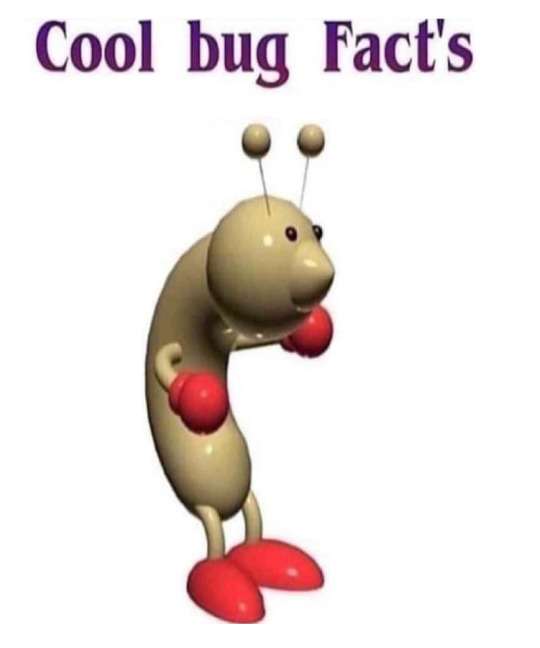
✨cool bug facts's✨
The Artipus floridanus, or the little leaf weevil! (Also called the little leaf notcher.)
They look like ༼ ◕ ◕ ༽
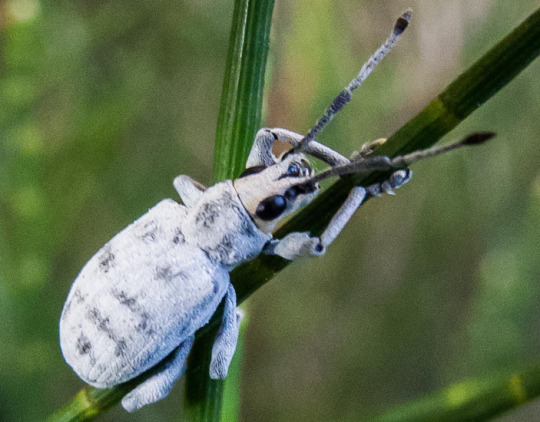
The anatomy of these glaucous insects!!!
They are one of the few weevils classified as a citrus root weevil, alongside the Diaprepes root weevil (Diaprepes abbreviatus), the blue-green citrus root weevil (Pachnaeus litus & Pachnaeus opalus), and the Fuller rose beetle (Asynonychus godmani).
The males grow between 5 to 7 millimeters long on average. The females can grow as long as 14 millimeters.
The larvae are around 9.5 millimeters long.
The males are smaller than the females, which is uncommon for beetles, but common for weevils and most other insects.
They are the only species in the genus Artipus found in the continental U.S., but they're limited to Florida.
They have longer and narrower elytra than other citrus weevil species.
While most citrus weevils have small hairs behind their eyes, the little leaf notcher does not.
They have purple splotches all throughout their body.
Diet.
They eat, somehow among other things, citruses, oranges, grapefruit, lime, peanut, avocado, mango, lima bean, Surinam cherry, and collards.
They eat the leaves off of citrus trees (Which can cause leaf injury). The males don't eat as much as females, and cause far less damage.
The larvae eat the roots of citrus trees, causing the trees to become predisposed to Phytophthora spp, which is a root rot pathogen, making the trees rot without any visible cause. This pathogen might also cause sudden death in trees.
Behavior.
The females lay around 1,220 eggs in their lifetime, and only lay them under dark or dim lighting conditions.
Similarly, they prefer to eat under darker lighting conditions.
The adults will only emerge April through July, and then take a break for a few months, emerging once again in October through November.
Habitat.
They live in Florida and the Caribbean area, particularly the Bahamas, and the American Virgin islands.
Their host plants are the lantana, sea grape, bottlebrush, rose, hibiscus, Australian pine, azalea, and sea oats.
The larvae build small chambers in their excrement where they pupate for 14 to 20 days.
The adults will only emerge depending on the temperature and precipitation. They usually prefer hotter temperatures and low precipitation.
#bugs#insects#beetles#weevils#true weevils#curculionidae#little leaf weevil#little leaf notcher#artipus floridanus#bugblr#entomology#coleopterology#cool bugs#cool bug facts#cool bug's#cool bug fact's
10 notes
·
View notes
Text
A forgotten gem from Florida
The American or Florida flagfish, Jordanella floridae, is a toothcarps endemic to Florida, a southern state of the USA, bordering the Caribbean Sea. It grows to 6.5 centimeters, or approximately 2 and a 1/2 inches length, and the adult males are more colorful, than are the drab juveniles and mature females, which also have less prominent dorsal and anal fins.
The habitat of J. floridae is shallow, richly vegetated freshwaters, including natural marshes and backwaters, as well as man-made canals and ditches. Near the coast, these habitats may be slightly brackish, sonetimes with fluctuating salinities, and it has been shown that at least temporary exposure of J. floridae, to specific gravities as high as 1.015, seemingly does these fish no harm. However, it is primarily a freshwater species by nature.
J. floridae requires a pH of 6.7 to 8.2, and a vegetated freshwater (or mildly brackish) environment, that is similar to its wild habitat requirements. It is a subtropical fish, from a part of North America with warm, rainy summers, and dry, mild winters from the middle of December through to the middle of April. The air temperture during the summer months may temporarily rise above 30 degrees centigrade, though probably, permanent exposure to such a temperture could be harmful, to the long term health of these fish. Whereas in the dry or winter season, air tempertures may drop to almost 11 degrees. The freshwaters of the Everglades are also described, as having a neutral pH.
Flagfishes are micropredators of zooplankton and small benthos, such as insect larvae. They also include algal or other plant material in their natural diet, although their primary reason for nipping at leaves, is to graze biofilms and their infauna. This species can be feed easily on proprietory aquarium foods, such as flake preparations. Unfortunately, some individuals may be boisterous, especially the males, who may even harass females of their own species.
0 notes